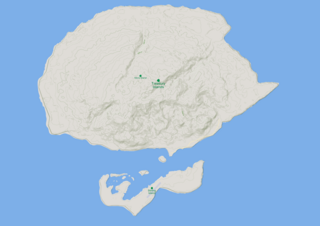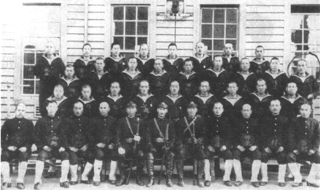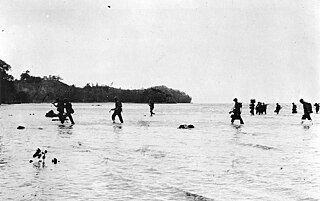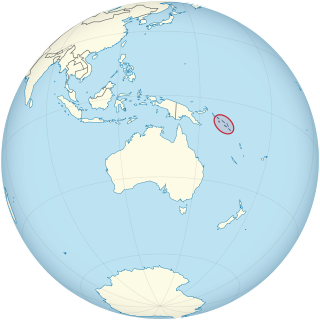
Stirling Island (also Sterling Island) is the smaller island of the Treasury Islands,in the nation state of Solomon Islands.

Stirling Island (also Sterling Island) is the smaller island of the Treasury Islands,in the nation state of Solomon Islands.
Stirling is about four miles (6.4 km) long and located some 17 miles (27 km) south of Shortland. The estimated terrain elevation above sea level is 35 metres (115 ft). [1] Stirling Island is separated from the largest Mono Island by Blanche Harbour. [2] Stirling Island is composed of coral which was once part of the barrier reef surrounding Mono Island.
Stirling Island has no permanent population. However an airfield and other remnants of World War II Allied base still remain here.

After the Allied Forces landed on Stirling, it became evident that the island was perfect for an airfield because the island was naturally flat, coral surfaced, with fresh water and good landing beaches locating nearby. A reconnaissance team from the 87th Naval Construction Battalion "Seabees" arrived on Stirling on November 1, 1943, to study the site, and four days later filed a favorable report about the area. Based on this report, a construction of a bomber strip "W", originally planned for Bougainville Island was initiated here. [3]
In May 2011, Solomon Islands Prime Minister Danny Phillip repeated offers to the Australian Government to make the disused air base available to host the processing of asylum seekers. It is believed that negotiations reached a reasonably advanced state before being discontinued.

The Battle of the Coral Sea, from 4 to 8 May 1942, was a major naval battle between the Imperial Japanese Navy (IJN) and naval and air forces of the United States and Australia. Taking place in the Pacific Theatre of World War II, the battle was the first naval action in which the opposing fleets neither sighted nor fired upon one another, attacking over the horizon from aircraft carriers instead.

The Coral Sea is a marginal sea of the South Pacific off the northeast coast of Australia, and classified as an interim Australian bioregion. The Coral Sea extends 2,000 kilometres (1,200 mi) down the Australian northeast coast. Most of it is protected by the French Natural Park of the Coral Sea and the Australian Coral Sea Marine Park. The sea was the location for the Battle of the Coral Sea, a major confrontation during World War II between the navies of the Empire of Japan, and the United States and Australia.
The Shortland Islands is an archipelago of Western Province, Solomon Islands, at 6.92°S 155.88°E. The island group lies in the extreme north-west of the country's territory, close to the south-east edge of Bougainville Island, Papua New Guinea.

Operation Chronicle was the Allied invasion of Woodlark and Kiriwina Islands, in the South West Pacific, during World War II. The operation was a subordinate action that formed part of the wider Operation Cartwheel, the advance towards Rabaul. An early planning name for this operation was Operation Coronet. Preliminary actions commenced on 23–24 June 1943 when small reconnaissance parties were landed on both islands. The main operation was executed without opposition on 30 June 1943. Around 16,800 personnel took part, divided into two forces. The United States Army provided the majority of ground troops, which were supported by a United States Marine Corps defense battalion as well as U.S. and Australian aircraft and naval vessels.

Treasury Islands are a small group of islands a few kilometres to the south of Bougainville and 24 kilometres from the Shortland Islands. They form part of the Western Province of the country of Solomon Islands. The two largest islands in the Treasuries are Mono Island and the smaller Stirling Island. The deep water strait between these two islands is called Blanche Harbour.

The Battle of the Treasury Islands was a Second World War battle that took place between 27 October and 12 November 1943 on the Treasury Islands group, part of the Solomon Islands. The battle formed part of the wider Pacific War and involved New Zealand and US forces fighting against Japanese troops. The majority of the ground forces were provided by the New Zealand 3rd Division.

The invasion of Tulagi, on 3–4 May 1942, was part of Operation Mo, the Empire of Japan's strategy in the South Pacific and South West Pacific Area in 1942. The plan called for Imperial Japanese Navy troops to capture Tulagi and nearby islands in the British Solomon Islands Protectorate. The occupation of Tulagi by the Japanese was intended to cover the flank of and provide reconnaissance support for Japanese forces that were advancing on Port Moresby in New Guinea, provide greater defensive depth for the major Japanese base at Rabaul, and serve as a base for Japanese forces to threaten and interdict the supply and communication routes between the United States and Australia and New Zealand.

Mono Island is the largest island of the Treasury Islands, Solomon Islands, at 7°21′S155°34′E.

Blanche Harbour is a natural harbour between Mono Island and Stirling Island of the Treasury Islands archipelago, located in the Western Province of Solomon Islands, at 7.4°S 155.55°E.

Rendova is an island in Western Province, in the independent nation of Solomon Islands, in the South Pacific, east of Papua New Guinea.

The Battle of Tulagi and Gavutu–Tanambogo was a land battle of the Pacific campaign of World War II, between the forces of the Imperial Japanese Navy and Allied ground forces. It took place 7–9 August 1942 on the Solomon Islands, during the initial Allied landings in the Guadalcanal campaign.
Mono Airport is an airport on Stirling Island in the Solomon Islands.
Munda International Airport is an international airport adjacent to the town of Munda, Western Province in Solomon Islands.

The Landings at Cape Torokina, also known as Operation Cherryblossom, took place at the beginning of the Bougainville campaign in World War II. The amphibious landings were carried out by elements of the United States Marine Corps in November 1943 on Bougainville Island in the South Pacific, as part of Allied efforts to advance towards the main Japanese base around Rabaul under Operation Cartwheel. Coming in the wake of Allied successes at Guadalcanal and in the central Solomons, the landings were intended to secure a beachhead with the purpose of establishing several bases from which to project air and naval power closer towards Rabaul, in an effort to neutralize the large Japanese force that had been established there.

The Landings on Rendova were amphibious military assaults by United States Army, Marine Corps and Navy forces on Rendova Island in the Solomon Islands on 30 June 1943. The small Japanese garrison was quickly overwhelmed by US troops, but the island was subjected to heavy attack by Japanese aircraft over several days. The landings were some of the first Allied landings during the New Georgia campaign of the Pacific War and were successful in securing the island and providing a base from which the Allies could support the subsequent invasion of New Georgia island and the eventual capture of Munda airfield in early August 1943.

The Battle of Wakde(Operation Straight Line) was part of the New Guinea campaign of World War II. It was fought between the United States and Japan from 17 May 1944 to 21 May 1944 in Dutch New Guinea. The operation involved an assault on the Japanese-held Wakde island group by a reinforced US infantry battalion, which was transported from a beachhead the Allied troops had established around Arara, on the mainland, the previous day. Following the capture of the island, fighting on the mainland continued until September as Allied troops advanced west towards Sarmi. In the aftermath, the island's airbase was expanded and used to support operations around Biak and in the Marianas.
Faisi is a small island in the Western Province of Solomon Islands. The island is a part of Shortland Islands archipelago.
Ro-100 was an Imperial Japanese Navy Ro-100-class submarine. Completed and commissioned in September 1942, she served in World War II, operating in the Solomon Islands, Rabaul, and New Guinea areas. She sank in November 1943 when she struck a mine during her seventh war patrol.

The Coral reefs of the Solomon Islands consists of six major islands and over 986 smaller islands, in Oceania, to the east of Papua New Guinea and northwest of Vanuatu. The Solomon Islands lie between latitudes 5° and 13°S, and longitudes 155° and 169°E. The distance between the westernmost and easternmost islands is about 1,500 km (930 mi). The Santa Cruz Islands are situated north of Vanuatu and are especially isolated at more than 200 km (120 mi) from the other islands. The Solomon Islands has the 22nd largest Exclusive Economic Zone of 1,589,477 km2 (613,701 sq mi) of the Pacific Ocean.

US Naval Base Solomons was a number of United States Navy bases in the Solomon Islands in the Pacific Ocean. Most were built by the US Navy Seabees, Naval Construction Battalions, during World War II as part of the Pacific War. In August 1942 the United States Armed Forces took the Guadalcanal in the Solomon, in the Battle of Guadalcanal. US Navy Seabees built a new base at Guadalcanal, Naval Base Guadalcanal and then on other islands in the Solomons.
7°24′43″S155°34′31″E / 7.411944°S 155.575278°E